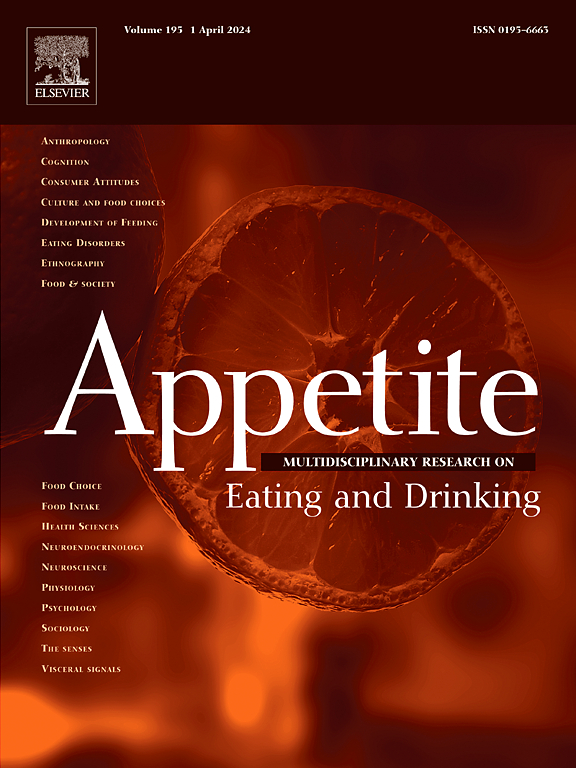Factors shaping adolescent snack choices in urban Bangladeshi schools: a mixed methods study
IF 4.6
2区 医学
Q1 BEHAVIORAL SCIENCES
引用次数: 0
Abstract
Research on adolescents' snack choices in school food environments has predominantly focused on high-income countries, leaving gaps in low- and middle-income contexts. This study addresses these gaps by examining snack choices and their individual, social and environmental influencing factors among adolescents in 20 urban high schools in Bangladesh using a mixed-methods approach guided by a conceptual model informed social cognitive theory (SCT) and an ecological perspective. Quantitative data were collected through surveys with 975 adolescents (ages 11–17), while qualitative data included focus group discussions with 60 adolescents. Adolescents frequently purchased energy-dense, non-nutritious snacks during school breaks, spending 10–20 Bangladeshi Taka (0.1–0.2 USD) daily. Individual factors such as taste were not widely prioritised in the quantitative survey but emerged as a central influence in the qualitative FGDs, often overriding health or hygiene considerations. While health considerations were frequently reported across both data sources, adolescents typically defined healthy food in terms of safety from contamination and chemical adulteration, rather than nutritional content. Many viewed home-cooked meals as compensating for less healthy snacks. Social peer influences were perceived as secondary in the survey data, yet qualitative findings revealed that peers exerted a significant influence through shared routines, group preferences, and subtle conformity. Environmental factors, including cost, availability, and hygiene, were cited less frequently in the survey but featured prominently in the FGDs. Adolescents often selected snacks based on affordability, accessibility, and perceived cleanliness, highlighting the influence of the school food environment on their choices. Interventions should generate demand for nutritious snacks, address food safety concerns, challenge compensatory health beliefs, and consider adolescents’ psycho-emotional stressors. Policies must reshape school food environments to ensure safe, affordable, and nutritious snacks.
影响孟加拉国城市学校青少年零食选择的因素:一项混合方法研究
关于青少年在学校食品环境中的零食选择的研究主要集中在高收入国家,在低收入和中等收入环境中存在差距。本研究以社会认知理论(SCT)概念模型和生态学视角为指导,采用混合方法研究了孟加拉国20所城市高中青少年的零食选择及其个人、社会和环境影响因素,从而解决了这些差距。通过对975名青少年(11-17岁)的调查收集定量数据,而定性数据包括对60名青少年的焦点小组讨论。青少年经常在学校休息期间购买高能量、无营养的零食,每天花费10-20孟加拉国塔卡(0.1-0.2美元)。在定量调查中,味觉等个人因素没有得到广泛的重视,但在定性fgd中却成为一个核心影响因素,往往超过健康或卫生方面的考虑。虽然在这两个数据来源中经常报告健康方面的考虑,但青少年通常根据免受污染和化学掺假的安全性来定义健康食品,而不是根据营养成分。许多人认为家常菜弥补了不太健康的零食。在调查数据中,社会同伴的影响被认为是次要的,但定性研究结果显示,同伴通过共同的惯例、群体偏好和微妙的从众行为施加了显著的影响。环境因素,包括成本、可用性和卫生,在调查中被引用的频率较低,但在fgd中却占有突出地位。青少年通常根据可负担性、可获得性和可感知的清洁度来选择零食,这突出了学校食品环境对他们选择的影响。干预措施应产生对营养零食的需求,解决食品安全问题,挑战代偿性健康信念,并考虑青少年的心理情绪压力源。政策必须重塑学校的食物环境,以确保安全、负担得起和有营养的零食。
本文章由计算机程序翻译,如有差异,请以英文原文为准。
求助全文
约1分钟内获得全文
求助全文
来源期刊

Appetite
医学-行为科学
CiteScore
9.10
自引率
11.10%
发文量
566
审稿时长
13.4 weeks
期刊介绍:
Appetite is an international research journal specializing in cultural, social, psychological, sensory and physiological influences on the selection and intake of foods and drinks. It covers normal and disordered eating and drinking and welcomes studies of both human and non-human animal behaviour toward food. Appetite publishes research reports, reviews and commentaries. Thematic special issues appear regularly. From time to time the journal carries abstracts from professional meetings. Submissions to Appetite are expected to be based primarily on observations directly related to the selection and intake of foods and drinks; papers that are primarily focused on topics such as nutrition or obesity will not be considered unless they specifically make a novel scientific contribution to the understanding of appetite in line with the journal's aims and scope.
 求助内容:
求助内容: 应助结果提醒方式:
应助结果提醒方式:


